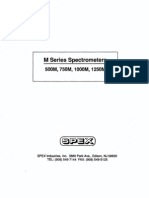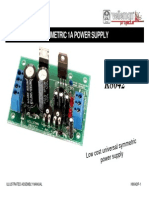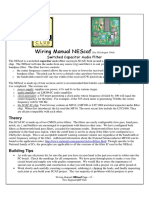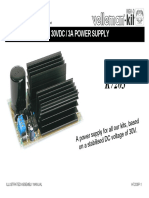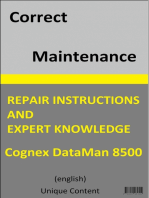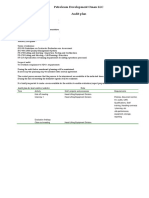Parking Radar: Parking Aid, or As Eye S' For Robo T Projec Ts
Parking Radar: Parking Aid, or As Eye S' For Robo T Projec Ts
Uploaded by
Balvendra SinghCopyright:
Available Formats
Parking Radar: Parking Aid, or As Eye S' For Robo T Projec Ts
Parking Radar: Parking Aid, or As Eye S' For Robo T Projec Ts
Uploaded by
Balvendra SinghOriginal Title
Copyright
Available Formats
Share this document
Did you find this document useful?
Is this content inappropriate?
Copyright:
Available Formats
Parking Radar: Parking Aid, or As Eye S' For Robo T Projec Ts
Parking Radar: Parking Aid, or As Eye S' For Robo T Projec Ts
Uploaded by
Balvendra SinghCopyright:
Available Formats
Parking Radar
K3502
ILLUSTRATED ASSEMBLY MANUAL H3502IP-2
Total solder points: 185
Difficulty level: beginner 1 2 3 4 5 advanced
U
s
e
a
s
p
a
rk
in
g
a
id
, o
r a
s
e
y
e
s
fo
r ro
b
o
t p
ro
je
c
ts
.
2
Specifications:
Detection range : 5cm - 1,5m (adjustable)
Detection angle : 5
Transmitter frequency : 40KHz.
Sample frequency : 26Hz.
Power supply : 10 - 15VDC / 16mA max.
Dimensions :
Sensor PCB : 28 x 95mm / 1,1 x 3,8
Base PCB : 48 x 125mm / 1,9 x 5
Features & Specifications
If you have problems parking then this kit is for you. Using (ultrasonic) sound waves, whose frequency is
beyond our range of hearing, we can "measure" a distance. Consequently, a sensor mounted at the back of
the car can give an indication of the distance between your car and the car parked behind you or other
obstacles (only at the same height as the sensor). When the preset minimum distance is crossed, an audible
signal is generated.
3
Assembly hints
1. Assembl y (Skipping this can lead to troubles ! )
Ok, so we have your attention. These hints will help you to make this project successful. Read them carefully.
1.1 Make sure you have the right tools:
A good quality soldering iron (25-40W) with a small tip.
Wipe it often on a wet sponge or cloth, to keep it clean; then apply solder to the tip, to give it a wet look. This is called thinning and will
protect the tip, and enables you to make good connections. When solder rolls off the tip, it needs cleaning.
Thin raisin-core solder. Do not use any flux or grease.
A diagonal cutter to trim excess wires. To avoid injury when cutting excess leads, hold the lead so they
cannot fly towards the eyes.
Needle nose pliers, for bending leads, or to hold components in place.
Small blade and Phillips screwdrivers. A basic range is fine.
For some proj ects, a basic multi-meter is required, or might be handy
1.2 Assembl y Hints :
Make sure the skill level matches your experience, to avoid disappointments.
Follow the instructions carefully. Read and understand the entire step before you perform each operation.
Perform the assembly in the correct order as stated in this manual
Position all parts on the PCB (Printed Circuit Board) as shown on the drawings.
Values on the circuit diagram are subject to changes.
Values in this assembly guide are correct*
Use the check-boxes to mark your progress.
Please read the included information on safety and customer service
* Typographical inaccuracies excluded. Always look for possible last minute manual updates, indicated as NOTE on a separate leaflet.
0
.0
0
0
4
Assembly hints
1.3 Soldering Hints :
1- Mount the component against the PCB surface and carefully solder the leads
2- Make sure the solder joints are cone-shaped and shiny
3- Trim excess leads as close as possible to the solder joint
REMOVE THEM FROM THE TAPE ONE AT A TIME !
AXIAL COMPONENTS ARE TAPED IN THE COR-
RECT MOUNTING SEQUENCE !
You will find the colour code for the resistances and the LEDs in the HALG
(general manual) and on our website: http://www.velleman.be/common/service.aspx
5
R1 : 10M (1 - 0 - 6 - B)
R2 : 22K (2 - 2 - 3 - B)
R3 : 27K (2 - 7 - 3 - B)
R4 : 27K (2 - 7 - 3 - B)
R5 : 47 (4 - 7 - 0 - B)
R6 : 10K (1 - 0 - 3 - B)
3. Resistors
R...
Construction
(A) Assembl y of the base PCB : P3502B
D1 : 1N4148
D2 : 1N4148
D3 : 1N4148
D4 : 1N4148
D5 : 1N4007
2. Diodes. Watch the polarity!
D...
CATHODE
IC1 : 16p
IC2 : 16p
IC3 : 14p
IC4 : 14p
IC5 : 16p
5. IC sockets, Watch the
position of the notch!
C1 : 12pF (12)
C2 : 12pF (12)
C3 : 22nF (223)
C4 : 10nF (103)
C5 : 100nF (104)
6. Capacitors
J
1. Jumpers
X1 : 5MHz
Fix the quartz crystal by means of
a jumpwire.
X...
4. Quartz crystal
6
Construction
C6 : 470F
7. Electrol ytic capacitor.
Watch the polarity !
C...
RV1 : 470K
RV1
8. Trim Potentiometer
J 1 : 2p +2p
J 2 : 2p +2p
9. Screw connectors
BUZ1
Be sure to put the longest
connection into the bore
marked +
10. Buzzer
IC1 : CD4060 or eq.
IC2 : CD4020 or eq.
IC3 : CD4068 or eq.
IC4 : CD4093 or eq.
IC5 : CD4049 or eq.
Pay attention to the position
of the notch!
11. ICs mounting
PIN 1
1
7
T1 : BC547B
3. Transistor
R7 : 15K (1 - 5 - 3)
R8 : 15K (1 - 5 - 3)
R9 : 15K (1 - 5 - 3)
R10 : 15K (1 - 5 - 3)
R11 : 1K (1 - 0 - 2)
R12 : 1K (1 - 0 - 2)
R13 : 10K (1 - 0 - 3)
R14 : 270K (2 - 7 - 4)
1. Resistors
R...
Construction
(B) Assembl y of the receiver PCB : P3502S
IC6 : 14p
Pay attention to the position
of the notch!
2. IC socket.
C7 : 10nF (103)
C8 : 10nF (103)
C9 : 100nF (104)
4. Capacitors
C10 : 10F
C11 : 100F
5. Electrol ytic capacitors.
Watch the polarity !
C...
J 1 : 3 x 2p
6. Screw connectors
8
Construction
SENS 1 : MA40A5S or eq.(marked with T).
SENS 2 : MA40A5R or eq. (marked with CTD)
Either on the print or connect them to the soldering terminals,
see chapter concerning the installation in the car.
7. Sensors
IC6 : TL074
Pay attention to the position
of the notch!
8. IC mounting
PIN 1
1
9
Connect the points GND, +V, RW, DIS, S1 and S2 of the main PCB to the corresponding points on the
receiver PCB.
Make sure that the distance between the receiver print and the base print is approx. 50cm.
Adjust the trimmer RV1 at the middle position RV1.
Connect a 12VDC power supply (or a battery) between the points GND (-) and +.
If you hold your hand or a sheet of paper in front of the sensors, you should hear the sound of the buzzer
when the distance from the object to the sensors decreases to about 70cm.
3. TEST
Test
Mount the receiver print in a synthetic housing, which can be done in two different ways (depending on
where it is built in on the car):
A) With the sensors in upright position (fig. 1):
Mount the four terminals for SENS1 and SENS2
Solder the sensors to the terminals so that they are in a traverse-position regarding the print.
Realise the bores in the housing as shown on the drawing (fig. 4).
4. INSTALLATION IN THE CAR
10
Install the print behind the bores using spacing sleeves,
so that the sensors are facing the bores properly without
touching the housing.
B) With the sensors in horizontal position (fig. 2):
In this case the sensors are simply mounted on the print.
Now realise the gaps in the housing as shown on the drawing 4.0
Install the print behind the bores using spacing sleeves, so that the sensors are
facing the bores properly without touching the housing.
REMARK: Cover the bores at the inside of the housing with a piece of very fine wire gauze (see fig.3). (if
the meshes of the wire gauze are to wide to prevent penetration of splash-water, the gauze should be
doubled up two or four times before fixing it to the bores). The sensors should be positioned properly
AGAINST the wire gauze which has been placed behind the bores.
Make a small hole in the bottom of the housing in order to enable the evacuation of the water that
eventually has infiltrated.
Installation
Fig. 1
Fig. 2
11
Installation
Close the housing as watertight as possible f.i. by using silicone.
Surch for a suitable place somewhere in the trunk, to built in the base print (by preference as close as possible to
the sensor, see below)
Find a suitable place, approximately in the middle of the backside of the car, for installing the sensors f.i. : underneath
or above the bumper. The sensors can be mounted directly behind the bumper as well, but then you will have to
perforate the bumper with holes of a corresponding diameter (or wider) there where the sensors are situated.
REMARK : The sensors should be in a 90 angle position to the soil.
Before fixing the receiver, first of all you have to connect a piece of
cable with 6 conductors (or shielded 5 cable with 5 conductors, the
shielding having to be connected to the terminal GND) to its terminals
(to the terminals GND, +V, RW, DIS, S1 and S2), so that it can be
connected afterwards to the base print (use by preference a color
coding cable).
SENSOR
CASE
FINE WIRE GAUZE
FINE WIRE
GAUZE
SENSOR
CASE
Fig. 3
POSITION OF SENSOR HOLES
Fig. 4
12
Connect the receiver to the base print.
Connect the terminal GND of the base print to the - of the car (chassis)
Connect the terminal + of the base print to the + of the reverse light.
5. DEFINITIVE CONNECTION
Connection & use
The circuit is activated as soon as the gear is shifted in reverse (this is marked by a 'bip' tone) and will detect
any obstacle within the range of the sensors, the detection distance (i.e. the sensitivity) being adjusted by
means of the trimmer RV1. A distance of approx. 25 to 30cm from the backside of the car seems to be a
value of practical use. First of all make some tests with the help of a second person who can survey the
distance from the outside (in order to avoid damaging the coach-work).
In case the buzzer cannot be heard clear enough, you can bring it closer to the driver by means of a 2
conductor extension cord.
REMARK : Be carefully when washing the car that no water is getting into the receiver (eventually you
should cover the sensors by means of adhesive tape).
6. USE
13
P
3
5
0
2
B
G
N
D
+
V
R
W
S
1
S
2
P3502B
P3502S
G
N
D
+
V
R
W
D
IS
+
G
N
D
G
N
D
+
V
R
W
D
IS
S
1
S
2
S
1
S
2
+
-
Connection
14
7. Schematic diagram (Control section)
Schematic diagram
15
PCB
PCB layout P3502S
PCB layout P3502B
8. PCBs
16
Modifications and typographical errors reserved
Velleman Components nv.
H3502IP - 2004 - ED2
VELLEMAN Components NV
Legen Heirweg 33
9890 Gavere
Belgium Europe
www.velleman.be
www.velleman-kit.com
5 410329 291594
You might also like
- M Series SPEX MonochromatorDocument20 pagesM Series SPEX Monochromatorstre0539100% (1)
- Soldering electronic circuits: Beginner's guideFrom EverandSoldering electronic circuits: Beginner's guideRating: 4.5 out of 5 stars4.5/5 (10)
- Parking SonarDocument20 pagesParking SonarBerkin Yaşar DilsizNo ratings yet
- Injetor Seguidor de SinalDocument12 pagesInjetor Seguidor de SinalLuiz Henrique SantosNo ratings yet
- Audio Video Transmitter KitDocument0 pagesAudio Video Transmitter KitKiTrojan Hadikusumo Jr.No ratings yet
- Led Theo NhacDocument16 pagesLed Theo NhacNguyễn Thắng LợiNo ratings yet
- Manual K8048 PicDocument0 pagesManual K8048 PicRed WarrantNo ratings yet
- 4 Channel Running Light: Creating Disco Ligh T Effects, Light Speed Ad Justable. Suited Fo R Inductiv e LoadsDocument12 pages4 Channel Running Light: Creating Disco Ligh T Effects, Light Speed Ad Justable. Suited Fo R Inductiv e LoadsNikola TesanovicNo ratings yet
- Illustrated Assembly Manual - Velleman K8042 Symmetric 1A Power SupplyDocument12 pagesIllustrated Assembly Manual - Velleman K8042 Symmetric 1A Power Supplymr_sharkNo ratings yet
- Welleman Illustrated Assembly Manual k8081 Rev2Document36 pagesWelleman Illustrated Assembly Manual k8081 Rev2adibzzNo ratings yet
- Temporizator Start StopDocument12 pagesTemporizator Start StopeliboyzzNo ratings yet
- FM Transmitter PDFDocument6 pagesFM Transmitter PDFGoncalo Escusa100% (1)
- DC To Pulse Width Modulator: Allows Very Eff Icient Control o FDC Motors, Heate Rs or LightsDocument0 pagesDC To Pulse Width Modulator: Allows Very Eff Icient Control o FDC Motors, Heate Rs or Lightsapostol_menNo ratings yet
- 2 X 15 Led Stereo Vu Meter: For High PR Ecision Aud Io Level IndicationDocument16 pages2 X 15 Led Stereo Vu Meter: For High PR Ecision Aud Io Level IndicationCarlos Enrique Falcon ZapataNo ratings yet
- Masurator de Camp FSI - Manual20170207Document8 pagesMasurator de Camp FSI - Manual20170207fox7878No ratings yet
- Cricket 80 AmanualDocument9 pagesCricket 80 Amanualdanielboiangiu4754No ratings yet
- Illustrated Assembly Manual k2032 Rev2Document12 pagesIllustrated Assembly Manual k2032 Rev2Long Nguyen KimNo ratings yet
- Service Manual: Color MonitorDocument47 pagesService Manual: Color MonitorGuido AmarillaNo ratings yet
- Illustrated Assembly Manual k8059Document12 pagesIllustrated Assembly Manual k8059zkovaNo ratings yet
- DX 6550Document45 pagesDX 6550victorino2009No ratings yet
- Illustrated Assembly Manual k4003 Rev1 PDFDocument12 pagesIllustrated Assembly Manual k4003 Rev1 PDFMilan MilosavljevićNo ratings yet
- Wiring Manual Nescaf: Switched Capacitor Audio FilterDocument31 pagesWiring Manual Nescaf: Switched Capacitor Audio Filterag1tatorNo ratings yet
- Instruction Manual: Model RSP Sanitary Electronic Pressure TransmitterDocument16 pagesInstruction Manual: Model RSP Sanitary Electronic Pressure Transmittergrincheu70No ratings yet
- Qrpguys Digital RF Probe: Parts ListDocument8 pagesQrpguys Digital RF Probe: Parts ListStevanus ColonneNo ratings yet
- SCAF Filter Buildv1.1Document8 pagesSCAF Filter Buildv1.1rspohnigNo ratings yet
- Ss-40ht Assembly Manual v1.1fDocument30 pagesSs-40ht Assembly Manual v1.1fIan McNairNo ratings yet
- 3-30v 3A Power Supply Circuit ManualDocument12 pages3-30v 3A Power Supply Circuit ManualRavindra ParabNo ratings yet
- Clarion Pn2165mDocument12 pagesClarion Pn2165mJorge NovoaNo ratings yet
- DIY Geiger Counter Radiation Detector Kit Ver.2 PDFDocument16 pagesDIY Geiger Counter Radiation Detector Kit Ver.2 PDFLeonardo VelezNo ratings yet
- ServiceManual CTV2131PFDVDDocument44 pagesServiceManual CTV2131PFDVDcroefus9525100% (1)
- ZX81 ServiceManualAndAssemblyInstructions PDFDocument43 pagesZX81 ServiceManualAndAssemblyInstructions PDFViorel AldeaNo ratings yet
- Stereo Coder PDFDocument3 pagesStereo Coder PDFDragonestaNo ratings yet
- Gold PicDocument6 pagesGold PicBalbalaManiukNo ratings yet
- Micro80D Builders Guide-Ver3Document18 pagesMicro80D Builders Guide-Ver3knujdloNo ratings yet
- SW20+ ManualDocument17 pagesSW20+ ManualhackmanNo ratings yet
- Philips Chasis l9Document58 pagesPhilips Chasis l9videosonNo ratings yet
- How To Build The KNQ7 Transceiver IssBDocument24 pagesHow To Build The KNQ7 Transceiver IssBJuanma IceNo ratings yet
- Illustrated Assembly Manual k8018Document16 pagesIllustrated Assembly Manual k8018FitzGritzNo ratings yet
- LCMeterHombrewmanual PDFDocument5 pagesLCMeterHombrewmanual PDFwayan.wandira8122No ratings yet
- Sony KDL 42W800A42W801A42W807A47W800A47W801A47W807A55W800A55W801A55W807A L3Document34 pagesSony KDL 42W800A42W801A42W807A47W800A47W801A47W807A55W800A55W801A55W807A L3pasantito100% (1)
- Led Circuit Diagram 3WDocument12 pagesLed Circuit Diagram 3WVinod Kumar Guravareddigari100% (1)
- Service Manual: History Information For The Following ManualDocument34 pagesService Manual: History Information For The Following ManualHamza AbbasiNo ratings yet
- Colour Television Chassis: Electrical Diagram's en PWB's Diagram PWBDocument30 pagesColour Television Chassis: Electrical Diagram's en PWB's Diagram PWBSotiris IoannouNo ratings yet
- Kit Manual IN14Document19 pagesKit Manual IN14Caio VilarNo ratings yet
- DIY Geiger Counter Radiation Detector Kit Ver.2Document16 pagesDIY Geiger Counter Radiation Detector Kit Ver.2Adrian PaleacuNo ratings yet
- Panasonic Th-37pv8p Th-37px8b Th-42pv8p Th-42px8b Th-42px8e Chassis Gph11deDocument173 pagesPanasonic Th-37pv8p Th-37px8b Th-42pv8p Th-42px8b Th-42px8e Chassis Gph11deYoly Rio RamosNo ratings yet
- Linear Power Supply: Model 9771-15 Assembly and Using ManualDocument20 pagesLinear Power Supply: Model 9771-15 Assembly and Using ManualCharles AustinNo ratings yet
- Dds 2016vmanualDocument11 pagesDds 2016vmanualalirisad aliNo ratings yet
- Electronic Transistor Ignition For Cars Kit Manual PDFDocument12 pagesElectronic Transistor Ignition For Cars Kit Manual PDFRaúl MartínNo ratings yet
- Panasonic Tc-42px14 Chassis Gph12du SMDocument108 pagesPanasonic Tc-42px14 Chassis Gph12du SMraulrosiqueNo ratings yet
- Modifications For The Kenwood TS-940Document10 pagesModifications For The Kenwood TS-940ursindNo ratings yet
- NorCal S9 Assy V1Document15 pagesNorCal S9 Assy V1Rudik WidNo ratings yet
- Dvpnc675p Sony DVDDocument98 pagesDvpnc675p Sony DVDLuis M L HerreraNo ratings yet
- Simple Diy Aoa Sensor v1Document14 pagesSimple Diy Aoa Sensor v1clanonNo ratings yet
- DX5000 Manual - NewDocument17 pagesDX5000 Manual - NewIonCristinelNo ratings yet
- Delco Manuals: Radio Model 633, Delcotron Generator Delco Radio Owner's Manual Model 633, Delcotron Generator InstallationFrom EverandDelco Manuals: Radio Model 633, Delcotron Generator Delco Radio Owner's Manual Model 633, Delcotron Generator InstallationNo ratings yet
- Delco Radio Owner's Manual Model 633; Delcotron Generator InstallationFrom EverandDelco Radio Owner's Manual Model 633; Delcotron Generator InstallationNo ratings yet
- Digital LED Thermometer with Microcontroller AVR ATtiny13From EverandDigital LED Thermometer with Microcontroller AVR ATtiny13Rating: 5 out of 5 stars5/5 (1)
- Radio Shack TRS-80 Expansion Interface: Operator's Manual Catalog Numbers: 26-1140, 26-1141, 26-1142From EverandRadio Shack TRS-80 Expansion Interface: Operator's Manual Catalog Numbers: 26-1140, 26-1141, 26-1142No ratings yet
- Diet Culture and InstagramDocument12 pagesDiet Culture and InstagramTheodor Stefan FilipNo ratings yet
- LKPD SMK Analytical Exposition TextDocument5 pagesLKPD SMK Analytical Exposition Texthendra khoNo ratings yet
- WORK-problem SolvingDocument4 pagesWORK-problem SolvingNanay GiNo ratings yet
- Select and Use Ict Tools For Teaching and Learning: Maricon D. Rempillo, MAIE Professorial LecturerDocument26 pagesSelect and Use Ict Tools For Teaching and Learning: Maricon D. Rempillo, MAIE Professorial Lecturermaria divina bitagoNo ratings yet
- Its27 Twin Fin ConceptDocument10 pagesIts27 Twin Fin ConceptmitsosNo ratings yet
- Questions 1Document9 pagesQuestions 1Sakina FatimaNo ratings yet
- OPL 9 - HSE Bullettin - Manual HandlingDocument1 pageOPL 9 - HSE Bullettin - Manual Handlingimam dianiNo ratings yet
- Research: Definition, Characteristics, Purposes, Types & ApproachesDocument4 pagesResearch: Definition, Characteristics, Purposes, Types & ApproachesJEREMAE CALANAONo ratings yet
- Space TechnologyDocument3 pagesSpace TechnologyDarnell SteeleNo ratings yet
- Application Form: Student Affairs and Development Division International Islamic University MalaysiaDocument5 pagesApplication Form: Student Affairs and Development Division International Islamic University MalaysiaUmair AlhadiNo ratings yet
- Assignment of Public Speaking Section A2Document2 pagesAssignment of Public Speaking Section A2Hamza KhalidNo ratings yet
- Group - 1 3 1Document90 pagesGroup - 1 3 1Ama Serwaa YeboahNo ratings yet
- 2021 年 9-12 月雅思口语 Part1 高频考题题卡 (初版)Document12 pages2021 年 9-12 月雅思口语 Part1 高频考题题卡 (初版)SANDYNo ratings yet
- Microcontroller Based DC To DC ConverterDocument3 pagesMicrocontroller Based DC To DC ConverterEmin KültürelNo ratings yet
- MariGreen LNG 4.0 Doeksen - Standard Modular LNG SystemDocument8 pagesMariGreen LNG 4.0 Doeksen - Standard Modular LNG Systemwon choiNo ratings yet
- Extending OpenMP To ClustersDocument1 pageExtending OpenMP To Clustersproxymo1No ratings yet
- JVC KD-SD631 Manuel D'utilisationDocument42 pagesJVC KD-SD631 Manuel D'utilisationteuiragNo ratings yet
- Resume Mohammad Sharifur Rahman 15+ Years Experience - Huawei TelecommunicationDocument7 pagesResume Mohammad Sharifur Rahman 15+ Years Experience - Huawei TelecommunicationSharifNo ratings yet
- Gradient and Directional Derivative ExampleDocument3 pagesGradient and Directional Derivative ExampleRobert0% (1)
- Heat Exchangers Sample 12Document4 pagesHeat Exchangers Sample 12Irfan SagalaNo ratings yet
- Himsen Cat h1728Document12 pagesHimsen Cat h1728Mohsen100% (1)
- Statement of PurposeDocument2 pagesStatement of PurposeMobasher HassanNo ratings yet
- Sewoo Slk-Te20x Series ManualDocument13 pagesSewoo Slk-Te20x Series ManualCesar Herrera GonzálezNo ratings yet
- Petroleum Development Oman LLC Audit PlanDocument1 pagePetroleum Development Oman LLC Audit PlanSreekumarNo ratings yet
- Tender Input Form: (A) Basic DetailsDocument4 pagesTender Input Form: (A) Basic DetailsSituationalsite ArchitectsNo ratings yet
- HV Impulse Attenuator - 1255Document3 pagesHV Impulse Attenuator - 1255Evandro MoNo ratings yet
- JMJ Marist Brothers Notre Dame of Marbel University: Alunan Avenue, City of Koronadal 9506 South Cotabato, PhilippinesDocument4 pagesJMJ Marist Brothers Notre Dame of Marbel University: Alunan Avenue, City of Koronadal 9506 South Cotabato, PhilippinesKurt Ryan JesuraNo ratings yet
- John's Case StudyDocument8 pagesJohn's Case StudySky KaurNo ratings yet
- Appendix 3 - The Written DocumentDocument29 pagesAppendix 3 - The Written DocumentNaomi Liang100% (1)
- Understanding Emulsifiers and Knowing When To Use ThemDocument4 pagesUnderstanding Emulsifiers and Knowing When To Use ThemyuzivengamNo ratings yet
